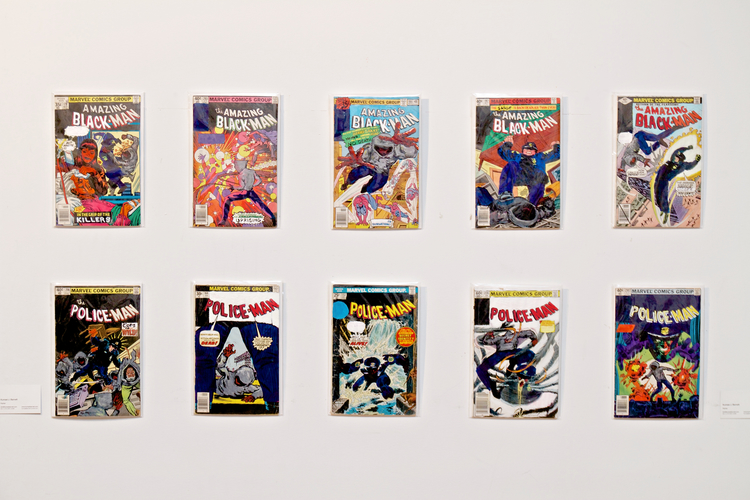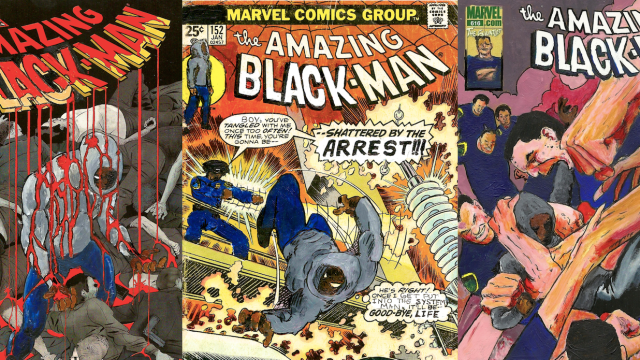Spider-Man is one of the most easily-identifiable characters in comic book history, but when I recently received a message from a colleague about artist Kumasi J. Barnett’s paintings based on the character, I could barely recognise him. Instead, all I saw was myself and all of the other black men living in America who keenly understand that despite our most valiant efforts, we are largely still seen as menaces to society.
Paintings from Barnett’s “The Amazing Black-Man” series. Illustration: Kumasi J. Barnett
It’s a theme that’s always been a part of Spider-Man comics, but the Baltimore-raised, Brooklyn-based Barnett brings the idea to the fore in a devastating way in his work – a series of paintings that are also remixed comic book covers which transform Peter Parker (and other superheroes) into an unnamed black man who faces off against hordes of brutal police officers. “The Amazing Black-Man” series re-imagines the webhead as a black man in a hoodie who, more often than not, is forced to protect himself from threats and dangers from the very people who’ve sworn to defend citizens such as himself. Instead of facing off against mutated goblins on hang gliders, Barnett’s Black-Man goes toe to toe with the kinds of white police officers who see his race and ethnicity as reason enough to kill him.
The paintings are a powerful statement about the everyday realities of people who aren’t typically featured in comics, and when I recently spoke with Barnett, he explained that it’s those kinds of experiences that he wants people to see in his work.
How did you first get into reading comic books?
Barnett: I basically learned how to read through comic books. There was a small library in Turner Station, the neighbourhood I grew up in, that had a collection of comic books thrown into a big chest. You couldn’t check them out so you had to read them there and even though the books weren’t in rotation, they were destroyed – creased pages and a lot of the covers were missing.
But they were like gold to us; my brother and I spent whole days there during the summer just reading comic after comic and when I finally got a job when I was a bit older, I started building a collection of my own. I started working pretty early so I have some comics in my collection from those early days.
How do you go about selecting which covers to paint?
Barnett: I usually start with a cover I find interesting or I work on a comic if it meant something to me as a child. I’m learning how not to be too exclusive in my selection though. Sometimes the initial comic imagery is something that I don’t like or something I don’t think would work. So far almost all have worked out. I plan on doing the entire run of The Amazing Spider-Man, though, which is less of a selection process.
In the process of altering each cover, I’m also creating a new story whose meaning becomes more and more obvious and clear the more you think about it. It’s like having a really blurry picture and then adjusting the lens of total shock in order to find a sharper narrative focus.

More covers from the series. Illustration: Kumasi J. Barnett
How would you describe the central thesis of your The Amazing Black-Man paintings? What’s the story that they tell as a series or are the pieces meant to be seen as discrete scenes?
Barnett: I feel like it’s America – surviving in America. I like to think of them as allegories. Each painting is a little vignette that’s telling a story about how for a lot of us, America is a dick punch when you go in for a hug. Our pop culture is the greatest resource that this country exports and it’s all designed to sell the American Dream, but it’s just that: A dream. My paintings take that dream and add a layer of our reality to it.
I want each printing to tell its own story, so I try to leave the narrative open and somewhat ambiguous, but I also include purposeful text and imagery to set the scene. It’s the viewer, really, who I want to piece together the scene and make sense of what’s happening and where the story ends. Of course that means that some people see things I never intended while other imagine the narrative exactly as I did.
Who are the heroes in your paintings? What kind of people are they and what is it that they’re fighting for?
Barnett: Each character’s a different hero. I don’t really describe one or another in too much detail because again, the story’s meant to exist in your mind. When you see the comic, you know the hero and the scenes depicted in the covers pretty much tells the story of who they are and what’s happening to them.
What do you want people to take away from your work?
Barnett: I want to start a conversation.

Comments
2 responses to “This Artist Transforms Spider-Man Comics Into Powerful Statements About Being Black In America”
Ah, racism at its finest. All caucasian cops are villainous killers, and any sort of violence in retaliation is acceptable. Saw how that went down in Dallas with the sniper who murdered those police. He was clearly just protecting himself like this artist fantasizes.
God this author frustrates me.
I need to stop clicking on his crappy articles!
Nope. Not gonna bite.